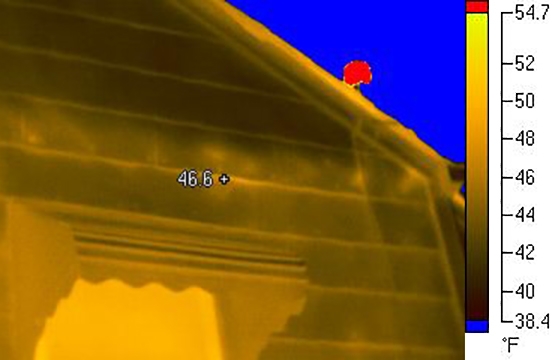

I’ve been asked that question many times. Unfortunately, that answer is driven mostly by what can be afforded, but building construction varies from what part of the country you’re from. In Florida, most residential exteriors are built using one of two methods. One method is concrete block construction or CMU construction. That’s short for Concrete Masonry Unit. The other method is an engineered wood frame construction.
A brick or stucco home is a little different. Brick/stucco is nonstructural and simply a face on the exterior that supports no weight other than its own. The roof is not attached or bearing weight on it. Brick facings can make an infrared inspection impossible due to a “thermal disconnection”. An airgap is located between the outer plywood and brick.
Stucco facing is a mortar type mix. It is applied in many layers. Properly installed, stucco can protect the building very well. Unfortunately, over time, water will start to delaminate and cause the stucco to pull away from the wall and fall off. Settling will cause cracks and eventually allow water to penetrate inside. In SW Florida, mold has the ability to grow very fast.
Each type of construction will have the pro’s and con’s for conducting a good thermal inspection. No matter which method, a basic knowledge of the construction is crucial. Ask a lot of questions!
Wood Frame Construction
The exterior walls are constructed with 2 x 4 or 2 x 6 dimensional lumber. The lumber member is spaced between 12″ and 16″ on center and is determined by using required building codes. The wall is anchored from the bottom of the wall at the slab to the top of the wall. The wall sits on a pressure treated 2×4 on top of a weather barrier that sits on the concrete slab itself.
Homes are designed for wind loads, sheer value, up lift and hold down protection. Rods, cables, clips and other hardware are incorporated into the design. The use of fasteners and nail spacing and patterns are also part of the design.
On both wood frame and CMU construction, the same wood roof trusses/rafters, sheeting and interior lumber walls are used. In the case of CMU homes, the second floor is usually built in wood frame for cost savings.
The exterior of the wall has OSB or plywood as sheeting with a certain nailing pattern applied to penetrate the wood studs for maximum strength and rigidity.
The insulation installed could be either fiberglass batts, blown cellulose or a sprayed foam insulation. Each will have its own unique thermal signature. The conditions for wood frame structures in accordance to ASTM C 1060 require an 18°F temperature difference (ΔT) from the interior surface and outside surface for at least four hours before the inspection. The sun’s energy could stay in wood frame construction for three hours.
Concrete Block Construction (CMU)
CMUs are cement blocks made from a mold in a factory. Typically, a residential exterior wall made from CMUs measures 8″ x 8″ x 16″ and is 80 % hollow.
The CMUs are laid on top of the slab in an interlocking staggered method and the wall is raised to its desired height. Mortar holds each block in place.
Once the CMU wall is constructed, some of the hollow block cells are filled with concrete in the cells that hold vertical rebar. The top of the wall consists of a “poured in place” concrete lintel that ties everything together.
Thermally, the sun’s energy can stay in this type of construction for up to eight hours! A thermographer may have to wait quite some time before any signatures start to appear. Strangely though, did you know that an eight inch masonry wall has a less R value than a ¼” pane of glass!
People wonder why Florida has a combination of both wood frame and concrete block homes. The northern part of the state as well as the panhandle and some central Florida areas are mainly built in wood frame. The other areas in the state generally build CMU homes even though the majority of homes with a second floor are constructed out of engineered wood frame construction.
It gets windy too!
In my opinion, either method is acceptable because both methods meet all current building codes which require the structure to withstand 120 mph winds and thermally performs properly. Some people prefer CMU because they think they will be safer in a hurricane. It is true that the exterior walls in a CMU home are more durable than a wood frame home, but just because a CMU home might have some exterior walls still standing after a hurricane, doesn’t mean the home wouldn’t be missing a roof, windows and doors, rendering it a total loss. Of course, the best idea for all of us is to leave town if a “Cat 4” hurricane (winds over 131 mph) is about to strike and let the insurance folks sort out the details later.
In the state of Florida when a home is either built or sold, a wind mitigation test must be conducted and passed. The inspector is looking for structural ties from the roof to the walls and the walls tied to the floors. It’s a good thing when the home doesn’t blow away due to hurricanes. Here in the near future, an infrared inspection may be required also.
Infrared will detect possible air leaks within the structure. Applications for Infrared Thermography Level 1 course covers proper infrared technics and the Standards set by ASTM for air leak detection in the Building Applications portion of the class. I think it is crucial that a Florida Professional Building Inspector take this class. Knowing structurally what we are thermally looking at will help show insulation conduction issues and performance issues, but knowing the right conditions to even doing the surveys should be understood.